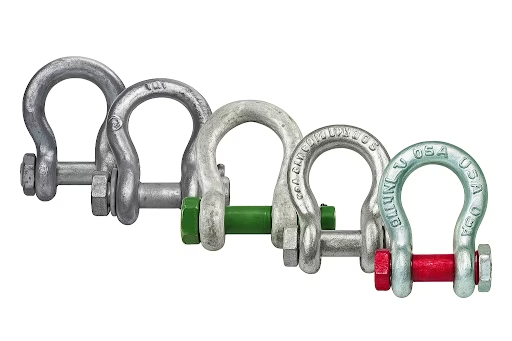In any lifting or rigging operation, the strength of your setup is only as reliable as its weakest point—and in lifting shackles, that point is often the pin. Choosing the right pin style isn’t just a matter of convenience; it directly impacts job site safety, load security, and the long-term integrity of your equipment.
At Murphy Industrial Products, Inc., we stock a full range of rigging shackles, including multiple pin configurations to suit varied lifting applications. Understanding the differences between these pin styles, along with their advantages and limitations, ensures you select the right shackle for the job and avoid costly or dangerous mistakes.
Screw Pin vs. Bolt-Type vs. Round Pin
Shackle pins come in three main configurations, each serving distinct purposes.
1. Screw Pin Shackles
- Feature a threaded pin that screws directly into the shackle body.
- Offer quick and easy attachment or removal, making them popular for temporary or frequently adjusted rigging setups.
- Commonly used in applications like load positioning, short-term lifts, and towing.
Advantages:
- Fast installation without tools.
- Ideal for scenarios requiring frequent connection changes.
Considerations:
- Not recommended for applications where the pin could rotate under load, as vibration can cause the pin to loosen.
2. Bolt-Type Shackles
- Use a bolt secured with a nut and a cotter pin.
- Designed for long-term or permanent installations where vibration or movement is present.
Advantages:
- Superior security under constant load or in high-vibration environments.
- Maintains pin position without risk of unthreading.
Considerations:
- Requires tools for installation and removal, which can slow down equipment swaps.
3. Round Pin Shackles
- Incorporate a smooth, unthreaded pin secured by a cotter pin.
- Commonly used in light-duty or tie-down applications.
Advantages:
- Simple design with quick pin insertion.
- Works well for applications where side loading is minimal.
Considerations:
- Less secure than bolt-type shackles in dynamic load scenarios.
Selecting the right pin style means matching the shackle’s intended use with the demands of the lift, factoring in duration, vibration, and the need for frequent adjustments.
Load Orientation and Pin Shear Strength
Choosing a shackle pin isn’t just about connection security—it’s also about ensuring the hardware can handle the forces it will encounter.
Load Orientation:
- Shackles are strongest when the load is applied in a straight line through the centerline of the pin.
- Side loading reduces the working load limit (WLL) and increases the risk of bending or deformation.
- In multi-leg sling setups, always verify the shackle’s angle rating from the manufacturer.
Pin Shear Strength:
- The pin must withstand both tensile and shear forces without yielding.
- Shear strength is critical when the pin is under direct load, as in basket hitch or towing scenarios.
- Always match the shackle’s WLL to the maximum expected load, including shock loading or dynamic movement.
By understanding how forces travel through the shackle, you can prevent premature wear and avoid pushing hardware beyond its safe capacity.
Inspection and PIN Security
Even the highest-grade rigging shackles require regular inspection to ensure ongoing safety.
Inspection Checklist for Shackle Pins:
- Thread Condition: For screw pins, check for worn, stripped, or damaged threads that could prevent full engagement.
- Bend or Deformation: Any visible bending of the pin indicates overload and requires immediate removal from service.
- Surface Wear: Look for scoring, pitting, or flattening where the pin contacts the shackle body or load.
- Corrosion: Rust, particularly on the pin’s bearing surfaces, weakens material integrity over time.
Pin Security Practices:
- For screw pins, fully engage the threads and hand-tighten firmly, then inspect for loosening before each lift.
- For bolt-type shackles, verify the nut is tight and the cotter pin is intact before every use.
- Avoid makeshift locking methods like wire wraps or tape—they can conceal damage and are not secure replacements for proper retention hardware.
Murphy Industrial Products, Inc. customers often choose heavy-duty shackles with durable coatings or stainless options for added corrosion resistance, especially in marine or outdoor environments.
When to Retire a Shackle
Knowing when to take a shackle out of service is just as important as choosing the right one in the first place. Continuing to use damaged crane shackles or pins risks equipment failure, injury, and costly downtime.
Immediate Retirement Indicators:
- The pin or body shows visible cracks, regardless of size.
- Permanent deformation, such as bending or elongation of pin holes.
- Significant corrosion or pitting reduces the cross-sectional area.
- Wear on the pin diameter exceeding 10% of the original size.
- Missing or damaged retention components, such as cotter pins or nuts.
Preventive Measures:
- Store shackles in a dry environment to reduce corrosion risk.
- Avoid mixing pins from different shackles, as tolerances may vary between manufacturers.
- Keep inspection records to track wear patterns and service life.
At Murphy Industrial Products, Inc., we advise replacing shackles as soon as inspection reveals any of the above issues, even if they still appear functional. Hardware costs are minimal compared to the risks of using compromised lifting gear.
Conclusion – Avoid Failure at the Pin Point
In rigging operations, the shackle pin is more than a simple fastener—it’s the safeguard that holds your entire lift together. Selecting the right style—whether screw pin for quick changes, bolt-type for secure long-term use, or round pin for lighter-duty applications—ensures your rigging shackles perform reliably.
By aligning pin selection with load orientation, understanding shear forces, and following strict inspection practices, you significantly reduce the risk of failure during lifts. Pair that with knowing when to retire worn or damaged hardware, and you create a safer, more efficient work environment.
For teams seeking dependable lifting shackles, heavy-duty shackles, or crane shackles that meet the demands of industrial lifting, Murphy Industrial Products, Inc. offers a complete line of products engineered for durability and safety. Visit our rigging shackles page to explore options built for the most challenging jobs.







